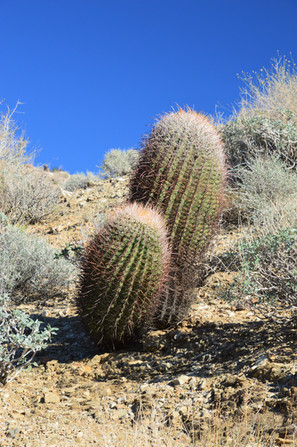Hike distance: 9.1 miles
Palm Canyon is part of the Indian Canyons, which is home to the Aqua Caliente Cahuilla Indian Tribe. In 1876, the US Federal Government deeded the Aqua Caliente people 32,000 acres of land in the Palm Springs area. Today, the land remains part of the Aqua Caliente tribe and the $9.00 entrance fees helps to maintain the trails and land - you will forget all about the price once you begin hiking in this area.
The trail head started in the parking lot and quickly followed transitioned to a few switch back leading down to the lower canyon. We were advised that there had been several rattlesnakes sightings in the area; therefore the warning sign.

We heeded the typical warnings. They don’t want to mess with you any more than you want to mess with them. Leave them alone, don’t go walking through areas where you cannot see where you are stepping, and you really have nothing to worry about. Just be aware, and be smart!!
Once in the canyon you realize how huge and densely packed the palms are. Palm Canyon is the largest native California fan palm oasis in the world.

Unlike in the city, this oasis was not a garden but left in a natural state. These 60 feet tall palms weren’t all neatly trimmed. They sported large brown skirts and the ground was loaded with fallen fan leaves and debris.


After walking through the palm forest for 15-20 minutes, the trees began to thin out and the trail climbed to higher elevations.

From this angle you can see snow on the San Jacinto and Santa Rosa mountain tops.

Looking back from a higher elevation, you can see how the fan palms follow the stream running through the lower canyon.

Once we crested the hills surrounding the lower canyon, the trail stayed on a high plateau. Once outside the influence of the stream, the flora began reflecting more of the typical desert environment.

Top left to right: Unknown type of cactus & Barrel cactus
Middle left to right: Agave & Cholla cactus

Beautiful views of the Santa Rosa Mountains as we climbed higher.


We came across some agave plants that had bloomed the previous season.

Agave bloom only once in their lifetime. Depending on the species and the conditions the plant is growing in, they will bloom somewhere between 10 and 30 years of age. When the plant get ready, the stalks that will bloom can reach up to 30 feet in height. Unfortunately, the plant dies shortly after it blooms.

We found a comfortable spot for lunch.

Continuing the hike up a wash located off the main canyon.

We came across another clump of California fan palms. From this point we could make out snow on some of the Santa Rosa peaks.


Shortly after reaching these palms we headed back to the car. Although Palm Canyon is more than 15 miles long, we turned around after hiking 4.5 miles of the canyon.









Comments